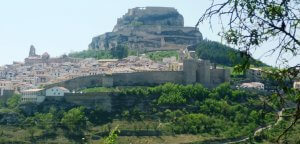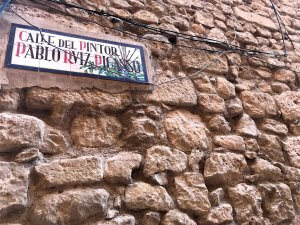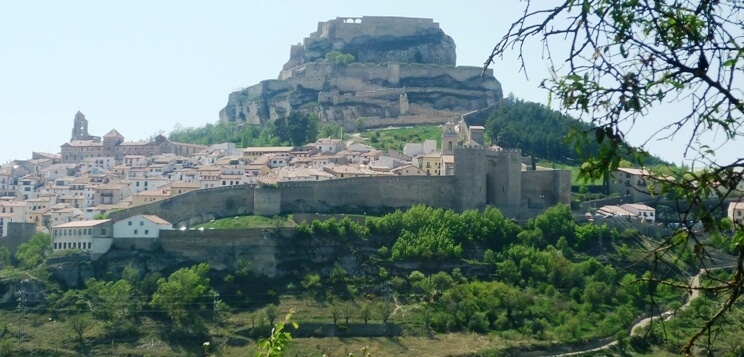Following in the steps of El Cid and the young Picasso, author Jimmy Burns discovered a magnificent landscape, picturesque towns and villages full of history and culture, as well as delicious food and wine on one of the less known tourist trails.
Under blue skies and bright sun, we set off last January early one morning from the Castell de la Suda, the one-time Moorish fortress converted into a comfortable Parador lodging with a commanding view of Tortosa, the only town of any size in Catalonia’s deep south.
A leisurely uncrowded drive takes us through lush green orange groves, and silvery olive trees bordering the River Ebro, and then we head for higher ground.
It is not quite a journey without maps, following the gentle winding road through the pass of Querol, but one that never ceases to throw up the unexpected. Our first sighting of Morella quite simply takes our breath away, and I stop the car so we can fully absorb its magnificence from a distance.
The walled town of ancient stone, whitewashed houses, rustic wood balconies and terracotta coloured roofs, is located in glorious isolation on its hill-top perch. It must count as one of the most impressively preserved and compact, as well as prettiest historic towns in Spain.
Hardly bustling with human activity during the winter months, Morella nonetheless is the capital of the Maestrazgo region in the province of Castellón, a crossroads that links Valencia, Aragon and Catalonia, the Mediterranean and the Ebro Valley, where much of the destiny of Spain has played out.
What remain of its extraordinary 13th century fortress straddles the town like an ever watchful, and proud Giant that has seen it all.

Amidst the castle ruins and sensitively conceived restoration work and exhibits, one discovers an enduring testimony to a region that epitomises Spain’s tortured conflict and capacity for survival, assimilation, and creativity.
Romans, Muslims, Christians, Frenchmen, Carlists, Republicans and Francoists have all fought in and around the castle, although the region has thankfully long ago disposed of much of its military ordinance and recovered its sense of its richly diverse cultural heritage and natural and mystical magic.
Having left the car outside the castle walls, our walk though streets selling local cheeses, textiles, honey, and wicker baskets, took us first to the Iglesia de Santa Maria. Built in various stages between the 13th and 16th centuries, it is considered one of the most beautiful Gothic churches in the region, with two wonderful entrances, one with statues of Virgins, the other of apostles.
The Church has an impressive baroque and a unique pipe organ with a beautiful flower-decked staircase designed and built in 1719 by the gifted Aragonese artisan Francisco Turull.
One of Morella’s most popular icons is a statue of the Virgin Mary to whom the town claims to owe its recovery from the plague in the seventeenth century, a historic landmark celebrated every six years, although the village has its main colorful fiesta with local folk dancing and parades of puppet giants every August.
In austere contrast stands the Franciscan convent at the foot of the Castle dating back to the 14th century. I find myself lingering for a while in a room called the ‘Sala de Profundis’ where monks were laid to rest before burial and prayed over. Murals depict the Dance of Death – a big red shining sun surrounded by the rope of St Francis Assisi, the Wounding Death figure shooting arrows against the Tree of Life – then the Crucifix as the Tree of Life itself, the Lignum Vitae, the symbol of never ending fecundity and cyclic regeneration.
As we emerge into the bright winter sunlight a sub-zero wind blows down from the Pyrenees, as we walk to the top of the Castle and from there take in a spectacularly mosaic-like expanse of terraced fields and wood.
Our three day journey, south from Barcelona, had begun twenty four hours earlier, on the coastal road to Valencia, before turning inland just south of Tarragona and heading towards the Terra Alta, to the town of Gandesa, at the foot of the region’s highest mountain range, the Puig Cavaller.
For any wine lover with the remotest interest in Spanish history this is a must pit-stop, with its Gaudiesque cooperative cellars designed at the beginning of the 20th century by the architect Cèsar Martinell y Brull, and the no less inspired Civil War museum dedicated to the memory of the defining Battle of the Ebro of 1938, the two buildings facing each other across the main street in a mutual statement of collective identity.
The museum has an impressive display of exhibits, digitalised maps, and recorded testimonies. It vividly depicts the cruelty and tragic loss of life that characterised Franco’s final push, supported by Italian and German air force, towards nationalist Spain’s conquest of Catalonia and the ill-conceived and vain-glorious attempt by Republican forces to thwart it, and the suffering of the vanquished once the Battle of the Ebro was over, with the loss of many thousands of lives.
It is hard not to reflect on the huge loss of human life and the destruction of nature by shells and shrapnel that once overshadowed the beautiful region we drive through, while at the same celebrating the care with which its landscape has since been cultivated and old villages restored, as well as the friendly reception we get from its local inhabitants wherever we go.
We drive on to the Matarraña region, Spain’s answer to Tuscany – only a thankfully less discovered tourist trail in one the more remote parts of Aragon.
We visit other gems in the Terra Alta – the beautifully preserved medieval hill towns of Calaceite, Cretas, and Valderrobles, before stopping near an olive grove where a flock of sheep are pasturing. There, we take in the striking shapes of the three large hills known as Benet’s Rocks – one of which is called the Dog’s Head because of its resemblance to that form.
Nearby, in a similarly spectacular position facing another mountain, and perfectly contained on its own high ground, is another picturesque village with a special claim to fame, Horta de Sant Joan.
The village draws its olive oil, almonds, and grapes from local fields, but also a reputation as the place the Malaga born Pablo Picasso lived and drew his inspiration from during different periods in his youth.
The first time was in 1898 when Picasso was a teenager, and visited with his friend Manuel Pallarès, a fellow student at Barcelona’s Llotja art school who was born and spent his childhood in Horta.
Picasso stayed for the second time in the village in 1909. Although already a full-time painter immersed in the artistic life of Paris, Picasso took great interest in Horta’s local customs and traditions. He drew his artistic inspiration from the medieval architecture of the village square to the light and geology of the surrounding landscape, not least the imposing mountain of Santa Bàrbara with the convent of Sant Salvador at its foot.
The village was silent and almost devoid of human life when we visited, almost like a ghost town, as if people were hibernating from the cold weather. We did find an old man stepping out of his house who pointed us to the building near the town square – the site of the Hostal del Trumpet where Picasso stayed with his lover and model the French artist Fernande Olivier during his Cubist period.

The building stood at the beginning of a street named after Picasso rather belatedly in 1967, at the height of Spain’s first tourist boom during the Franco regime, in recognition of his international fame. It is a few hundred yards away from a Picasso Centre displaying facsimile reproductions of all the works the artist created in Horta during his time there.
Even more off the beaten-track and not recommended if the elements are against you is a visit to a local cave where, in the summer of 1898, Picasso and his student friend Pallarès lived for several weeks, in order to ‘live’ nature, a rites of passage experience from which Picasso emerged determined to break with formal artistic training and instead both experiment and innovate as an avant-garde painter.
I have to admit that the sub-zero temperature drew us away from mountain walks which would have been hugely attractive in the warmer months of Spring and Autumn, and instead towards inner sanctuaries such as various warm eateries to sample the delicious local mutton, and goat, and restorative local red wine.
But I am told that when the weather is warmer, it is well worth doing the 3km hike from the ‘Parc de la Fraqueta’ to Picasso’s Cave , which is actually a rock projecting out from the mountain and where one can easily imagine Picasso and his friend – two young students, dreaming the artistic dream of a return to nature.
This article first appeared in La Revista, published by the British Spanish Society.
Jimmy Burns is an award winning journalist and author, who wrote the internationally acclaimed Hand of God: a biography of Diego Maradona. His most recent book is Cristiano and Leo.


